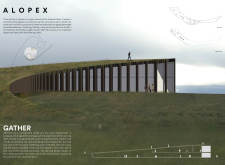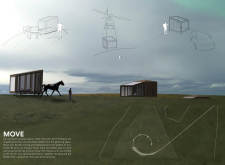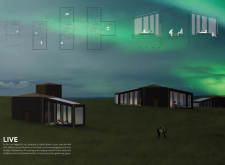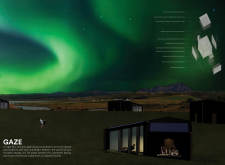5 key facts about this project
The project serves multiple functions, primarily aimed at providing a welcoming space for both social gatherings and solitary retreats. Central to its design are flexible living arrangements that allow occupants to choose between communal living and private spaces, thus accommodating various user preferences. This duality emphasizes the project's commitment to addressing the diverse needs of visitors. The arrangement is intuitive, facilitating movement and interaction while offering opportunities for personal reflection in more intimate settings.
Key elements of Alopex include the central gathering area, designed to promote social engagement. This space serves as the heart of the campground, where visitors can come together for various activities and communal dining. The architectural configuration of the gathering area invites a natural flow, encouraging occupants to explore and interact with one another. Surrounding this core are a series of modular units that provide both fixed and movable living spaces. These units, which are thoughtfully insulated and designed for comfort, allow occupants to adapt their experience based on changing weather and personal preferences. By enabling movement, the project ensures a dynamic environment that enriches visitor interactions with nature and each other.
Another notable aspect of the design is the incorporation of large glass panels that enhance the connection between the interior and exterior environments. These glass elements invite natural light into the living spaces while offering stunning views of the Icelandic surroundings, including the mesmerizing spectacle of the Northern Lights. The design emphasizes engagement with the natural world, allowing occupants to feel immersed in their environment, whether they are relaxing indoors or enjoying the scenic vistas outside.
The material selection further establishes a sense of place and sustainability. Wood, used extensively as a construction material, evokes a sense of warmth and comfort while blending seamlessly with the natural setting. Additionally, lightweight framing systems contribute to the overall adaptability of the units, supporting the project’s ethos of mobility and flexibility. The careful choice of insulation materials ensures thermal efficiency, providing a comfortable atmosphere in colder climates typical of the region.
What sets Alopex apart is its unique design approach that prioritizes community-oriented spaces while still allowing for individual privacy. The project challenges traditional camping experiences by redefining how communal and private spaces can coexist without compromising on comfort or accessibility. Visitors can engage with one another in shared areas or retreat to their personal quarters, enriching their experience through choice.
The spatial arrangement is a key factor that enhances the overall user experience. Each module aligns with the gathering area, forming a cohesive layout that facilitates both movement and accessibility. The emphasis on visual and physical connectivity reflects a broader architectural idea aimed at integrating the built environment harmoniously within the landscape.
In summary, the Alopex project represents a thoughtful convergence of architecture, nature, and community experience. By exploring this campground's presentation, readers can gain deeper insights into its architectural plans, sections, designs, and ideas. The project exemplifies an adaptive approach to contemporary camping, making it a relevant case study in architectural practice today. For more details, readers are encouraged to review the project's presentation and explore the nuances of its design.


























